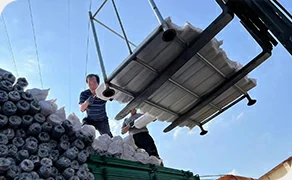 TEL:
+86-13102802206
TEL:
+86-13102802206
 Email:
fencenetting@china.com
Email:
fencenetting@china.com
 Language
Language
 TEL:
+86-13102802206
TEL:
+86-13102802206
 Email:
fencenetting@china.com
Email:
fencenetting@china.com
 Language
Language


The Significance of Barbed Wire on the Inside of Fences
Barbed wire has long been a symbol of security and control. Often associated with prisons, military installations, and agricultural properties, barbed wire fences create physical barriers that aim to deter unauthorized access. While the typical installation may see barbed wire placed on the top of fences to prevent climbing, placing barbed wire on the inside of fences serves specific and important purposes that extend beyond mere deterrence.
Traditionally, barbed wire is designed as a defensive mechanism. When installed atop a fence, its primary role is to deter intruders from scaling the height of the structure. However, the use of barbed wire on the inside of a fence flips this concept on its head. Instead of focusing solely on external threats, it creates a formidable barrier against internal threats, making it equally effective in controlling movement within the enclosed space.
The Significance of Barbed Wire on the Inside of Fences
In agricultural settings, barbed wire fences with internal barbed wire can also serve a critical function. Farmers often use such configurations to protect livestock from predators and unauthorized entry. In some cases, an inner perimeter can also segregate different types of animals to avoid fights, or keep newborns safe from more aggressive adults. This strategy ensures that animals stay within designated areas while preventing any stray animals – or potential poachers – from entering.

Moreover, installing barbed wire on the inside of fences can help create designated boundaries among different zones within a property. In industrial settings, for example, this can prevent unauthorized personnel from wandering into hazardous areas or sensitive zones. The presence of barbed wire discourages individuals from straying off designated pathways, thereby not only maintaining security but ensuring safety and compliance with safety regulations.
Beyond physical deterrence, barbed wire can also serve psychological purposes. The mere sight of barbed wire can have a profound impact, instilling a sense of danger and emphasizing the seriousness of trespassing. The imprint of such barriers is often powerful—serving as a visual reminder of the consequences an intruder may face, whether in urban environments, rural settings, or within the confining walls of correctional facilities.
On a broader level, the implementation of barbed wire on the inside of fences fits into larger discussions around security, privacy, and ethics. Critics may argue that such measures can foster an atmosphere of distrust and hostility. In contrast, proponents of security-enhancing infrastructure assert that the implementation of such systems is necessary for ensuring safety and protecting property rights.
As societies continue to evolve, the conversation around the use of barbed wire is indicative of broader trends concerning security concerns versus civil liberties. While the application of barbed wire inside fences remains a practical security measure, it raises questions about the balance between safety and the right to privacy or freedom of movement. How we secure spaces—and against whom—shapes both the physical and social landscapes of our environments.
In conclusion, barbed wire on the inside of fences is a nuanced topic that encompasses a wide range of concerns, from prison security to agricultural practices and industrial safety. It serves as a reminder of the complexities associated with creating secure environments amidst evolving societal values. Whether seen as a protective barrier or an instrument of control, the design and placement of barbed wire will continue to spark discussion as we navigate the delicate balance between security and freedom.